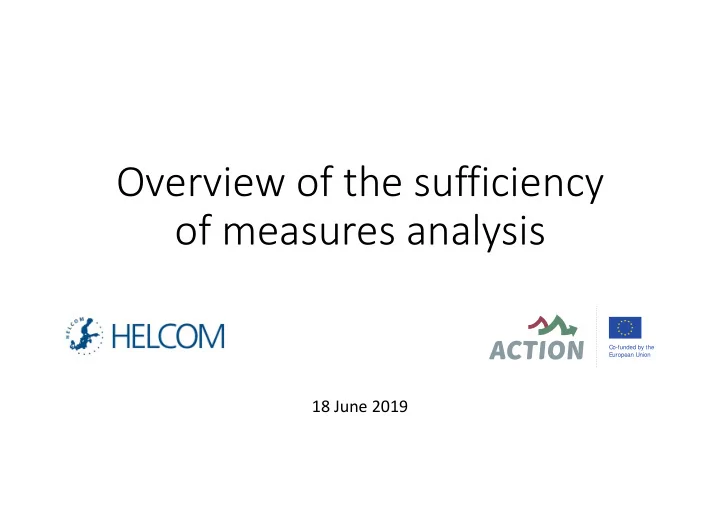

Overview of the sufficiency of measures analysis Co-funded by the European Union 18 June 2019
Business ‐ as Business as ‐ usual usual (BAU) U) state state GES GES Environmental status gap Example business ‐ Possible BAU states as ‐ usual (BAU) state Measures Change in human activities 2016 20XX (end year of BAU) Time
Ov Over erall all SOM OM appr approach oach Projected development of activity by 20XX GES GES Activity/ gap sector Pressure e.g. agriculture, Existing e.g. input of shipping Sub nutrients, measures input of litter GES State in Need for Comparison year new BAU vs. GES 2033 measures (BAU) SOM analysis
SOM components [A] Measure list, implementation status, type, endpoint, time lags (Steps 1 ‐ 2) [B] Activity list from MSFD Annex III [C] Pressure list from MSFD Annex III [D] State components/indicators list from HOLAS II Projected [1] Measure ‐ activity link (Step 1) [2] Activity ‐ pressure link and relative contribution of activity to pressure (Step 3) development [3] Effect of measure on pressure from activity (% Δ ) (Step 4) of activity by [4] Effect of measure on pressure (% Δ ) (Step 4) 20XX [5] Effect of measure on state (Step 4) [6] Effect of changes in pressures on state (Step 6) [7] [7] [7] Projected changes in activities or pressures (Step 5) [D] [A] [B] [C] Activity [2] [3] [6] [1] Pressure State in Existing year 20XX [4] [6] measures (BAU) (grouped) [5]
SOM components [A] Measure list, implementation status, type, endpoint, time lags (Steps 1 ‐ 2) [B] Activity list from MSFD Annex III [C] Pressure list from MSFD Annex III [D] State components/indicators list from HOLAS II Projected [1] Measure ‐ activity link (Step 1) [2] Activity ‐ pressure link and relative contribution of activity to pressure (Step 3) development [3] Effect of measure on pressure from activity (% Δ ) (Step 4) of activity by [4] Effect of measure on pressure (% Δ ) (Step 4) 20XX [5] Effect of measure on state (Step 4) [6] Effect of changes in pressures on state (Step 6) [7] [7] [7] Projected changes in activities or pressures (Step 5) [D] [A] [B] [C] [2] Activity [2] [3] [6] [1] Activity ‐ pressure link and relative [A] [7] [D] [4] [5] [6] Pressure contribution of activity to pressure [C] [1] [B] State in (Step 3) Existing Measure list, implementation year 20XX [4] [6] Projected changes in activities or Effect of measure on pressure measures Effect of changes in pressures on State components/indicators list Effect of measure on state (BAU) Pressure list from MSFD Annex III Activity list from MSFD Annex III status, type, endpoint, time lags Measure ‐ activity link (Step 1) (grouped) [3] pressures (Step 5) from HOLAS II state (Step 6) (% Δ ) (Step 4) (Step 4) (Steps 1 ‐ 2) Effect of measure on pressure from [5] activity (% Δ ) (Step 4)
Sufficiency of the current BSAP: Our approach 2nd main outcome: 1st main outcome: Improvement of Total reduction of state components each pressure (%) (%) 6
MEASURES • all types, except research, monitoring, coordination, indicators, targets, information systems/tools etc.) • measures presented as groups to be considered jointly • ’old measures with time lags’ + ’ongoing measures’ • we assume full implementation taking place • we assume full effect taking place • list ’relevant’ measures for each pressure and state components (conservation and restoration measures)
Aquaculture – land Agriculture ACTIVITIES Forestry Non ‐ renewable energy generation (fossil fuel and nuclear powerplants) Land claim Transport – air, including infrastructure • List of 33 activities adapted from MSFD Annex III Transport – land (cars and trucks, trains), including infrastructure Urban uses (land use) Industrial uses (oil, gas, industrial plants) Waste waters (urban, industrial, and industrial animal farms; includes all waste streams entering waste water systems e.g. microplastics, pharmaceuticals, etc.) Solid waste (e.g. land ‐ based disposal of dredged material, land ‐ fill, solid waste streams) Canalisation and other watercourse modifications (coastal dams, culverting, trenching, weirs, large ‐ scale water deviation) Coastal defence and flood protection (seawalls, flood protection) Aquaculture – marine, including infrastructure Renewable energy generation (wind, wave and tidal power), including infrastructure Transmission of electricity and communications (cables) Fish and shellfish harvesting (bottom ‐ touching towed gears, professional, recreational) Fish and shellfish harvesting (pelagic towed gears, stationary gears, professional, recreational) Fish and shellfish processing Marine plant harvesting Hunting and population control Extraction of minerals (rock, metal ores, gravel, sand, shell) Extraction of oil and gas, including infrastructure (e.g. pipelines) Offshore structures (other than for oil/gas/renewables) Restructuring of seabed morphology (dredging, beach replenishment, sea ‐ based deposit of dredged material) Tourism and leisure infrastructure (piers, marinas) Tourism and leisure activities (boating, beach use, water sports, etc.) Transport infrastructure (harbours, ports, ship ‐ building) Transport – shipping (incl. anchoring, mooring) Military operations (infrastructure, munitions disposal) Research, survey and educational activities (seismic surveys, fish surveys) Activities and sources outside the Baltic Sea Region Marine and coastal construction
Linking Activities to Pressure
Linking Measures to Pressure
PRESSURE REDUCTION MEASURE GROUP TOTAL PRESSURE REDUCTION CONTRIBUTION % REDUCTION% p ACTIVITY 1 50 0 0 ACTIVITY 2 25 0 ‐ 5 0.2 ACTIVITY 3 10 5 ‐ 10 0.7 ACTIVITY 4 10 10 ‐ 20 0.1 ACTIVITY 5 5 20 ‐ 30 0 ACTIVITY 6 0 … 0
PROJECTED DEVELOPMENT OF PRESSURES MEASURE TOTAL PRESSURE GROUP REDUCTION TOTAL PROJECTED FINAL PRESSURE PRESSURE PRESSURE REDUCTION DEVELOPMENT REDUCTION 12
Recommend
More recommend